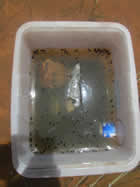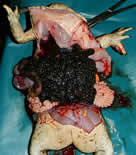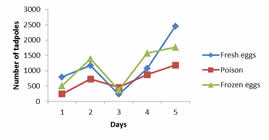|
KIMBERLEY TOAD BUSTERS NEWSLETTER
51:
02/12/2013
The Cane Toad is a Key Threatening Process to the Australian Nation
Declared by the Federal Government 12 April 2005
KTB Newsletter 51
2013 United Nations Finalist as well as finalist in 7 other state, national and
international awards since 2006.
Prepared by Jordy Groffen– Animal Scientist & KTB Researcher 26/11/2013.
The Kimberley Toad Busters’ Newsletter is produced by Kimberley Specialists In Research
Inc in conjunction with Kimberley Toad Busters Inc. Kimberley Specialists, a founding
member of the Kimberley Toad Busters, continues to support the campaign by maintaining
www.canetoads.com.au; raising funds and supporting cane toad scientific research.
KTBs are a tax deductible charitable entity. Please see our website for our direct donation
facility, or ways in which you can sponsor community toad busting efforts or one of our
research or educational projects.
IF EVERYONE WAS A TOADBUSTER, THE TOADS WOULD BE BUSTED!
kimberleytoadsbusters@canetoads.com.au
www.kimberleyspecialists.com.au
kimberleyspecialists@westnet.com.au
Newsletter contents:
1. Community Friendly Cane Toad Tadpole Traps
1. A more community friendly tadpole trap?
Kimberley Toad Busters and their many volunteer researchers are always looking for better and more efficient ways of dealing with the various breeding cycles of the cane toad, particularly at the tadpole stage. While removing large adult toads from the environment is critical, it is self defeating if subsequent breeding is not also dealt with. Only by taking as many eggs, tadpoles and metamorphs from the system, as well as adult toads, can we hope to achieve any real success in mitigating cane toad impact on our native biodiversity.
Crossland et al. (2012) came up with a new and very helpful toad control tool, a tadpole trap. With this trap you can catch thousands of tadpoles in one go. KTB researcher Jordy Groffen and biodiversity officer Gary Rethus evaluated the method and conducted an experiment.
Cane toad tadpoles are known to attack and kill freshly laid cane toad eggs to reduce competition (Alford, 1994; Crossland et al., 2012). The tadpoles are attracted by a chemical released from the eggs. In the newly developed cane toad trap, bufotoxin from adult toads, which contains the same chemical as the eggs, will attract tadpoles in a similar way (Crossland and Shine, 2011; Crossland et al., 2012).
They chose to “milk” the toads for bufotoxin instead of using eggs for bait, because the toad parotoid secretion is easy to collect whilst eggs are only seasonally available (Crossland et al., 2012). Furthermore the eggs retain for only a day or two after oviposition (Crossland et al. 2012). KTB anecdotal evidence indicates that cane toads (in the right environment) do lay eggs twelve months of the year and that less than 12 hours after oviposition the eggs have already broken down, making it impossible to pull them out of the water.
 |
President and co-founder of KTB, Lee Scott-Virtue stated; “KTB is always open to new ideas to capture toads, and we tried the tadpole trap idea (with some modifications of our own) in different areas, with good results”. KTB biodiversity officer Gary Rethus continued; “We trapped thousands of tadpoles in a couple of days, and when we refreshed the bait daily it was possible to almost clear the waterhole from cane toad tadpoles”.
While the volunteers of KTB are used to doing dirty jobs, “milking” toads is not one of their favourites. Gary Rethus stated “Milking cane toads is hard dirty and potentially dangerous, so we started looking at different ways of getting the bufotoxin we required for the traps”. KTB works with many volunteers of all ages and squeezing and working with toad poison can be extremely dangerous with children around. So KTB had to think further. |
Jordy Groffen further stated that “In the article by Crossland et al. (2012) the argument for choosing the bufotoxins from the adult toad was due to egg availability, which gave us an idea”. KTB collects hundreds of toads a week, often with a fair majority of them being female toads. Dissections are often conducted and almost every female is found to be carrying eggs. “So why not use undeveloped eggs taken from female toads?” Jordy Groffen asked. “In addition, we felt that by freezing them could increase the egg retention time”.
| |
Female toads with eggs used for the experiment |
|
 |
KTB researcher Jordy Groffen and KTB biodiversity officer Gary Rethus performed a small experiment to find out if more community-friendly bait for the tadpole traps would work. Gary Rethus said “We chose a waterhole that was one of the major breeding areas of cane toads near Kununurra, with decent numbers of Australian biodiversity still present, like beetles, rainbow fish and different water birds”. Jordy Groffen added “Gary and I constructed three tadpole traps (with shade cloth on top), one had parotoid secretion of four adult toads as bait, the other one had fresh eggs from one female toad as bait and the last one had eggs that had been frozen for 12 hours from one female. The traps where placed 3m apart within the same waterhole.”
Over 5 days close to 15.000 tadpoles were captured. 3481 with the poison bait, 5705 with fresh eggs as bait and 5601 with frozen eggs as bait, see figure 4. “Our hypothesis was proven right” said Jordy Groffen. While most tadpoles where captured in the trap with fresh eggs as bait, only 100 less were captured with the frozen eggs and both ‘egg traps’ captured approximately 2000 more tadpoles than the trap with parotoid secretion bait. Gary Rethus stated that “Most tadpoles in the trap with the egg baits were dead, this was probably due to the only by-catch we had: dytiscid beetles.” “The beetles were active and alive while most tadpoles were dead and partly eaten. We released the beetles back into the pound to continue their hunt for tadpoles”
| Gary Rethus continued. |
Figure 3. dytiscid beetle found in the traps (Photo:http://www.anbg.gov.au) |
|

|
 |
| Number of tadpoles captured with, Poison bait, Fresh eggs as bait and frozen eggs as bait in 5 days |
The last word goes to Lee Scott-Virtue “KTB will continue the experiment with the tadpole traps and frozen eggs, to see how long the eggs can be frozen and still attract cane toad tadpoles. If the bait still works after a long period in the freezer, KTB might think of preparing lots of bait to give away to people that want to fight the cane toad by trapping the tadpoles. The traps are simple and economical to make and could easily become part of a school project”.
Literature list
• Alford R. A. 1994 Interference and exploitation competition in larvalBufo marinus. In Advances in ecology and environmental studies (edsMishra P. C., Behara N., Senapati B. K., Guru B. C.), pp. 297–306. New Delhi, India: Ashish Publishing House
• Crossland M. R., Shine R. 2011 Cues for cannibalism: cane toad tadpoles use chemical signals to locate and consume conspecific eggs.Oikos 120, 327–332.
• Crossland M. R., Hearnden M. N., Pizzatto L., Alford R. A., Shine R. 2011 Why be a cannibal? The benefits to cane toad (Rhinella marina) tadpoles of consuming conspecific eggs. Anim. Behav. 82, 775–782.
For more information and/or data from this survey please go to our website
www.canetoads.com.au
Or contact us on kimberleytoadbusters@canetoads.com.au
Phone 08 91682576 or 08 91687080.

Kimberley Toad Busters awards!
For more information on any of the articles contact:
Lee Scott-Virtue: KTB Founder & President 08 9168 7080 kimberleytoadbusters@canetoads.com.au
All donations are tax deductible.
Sponsors

|





